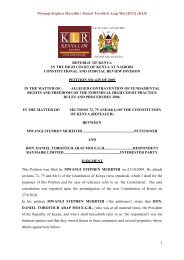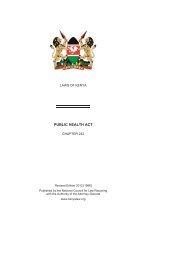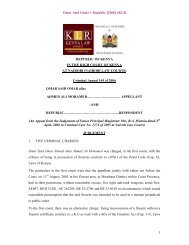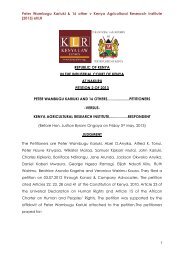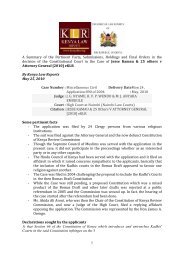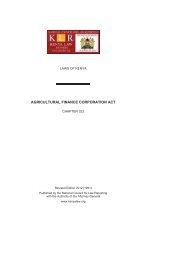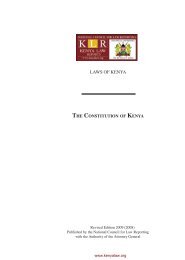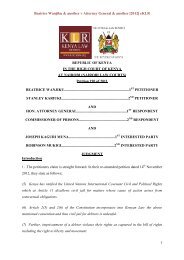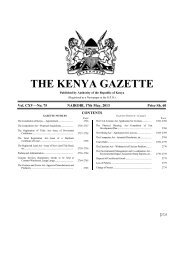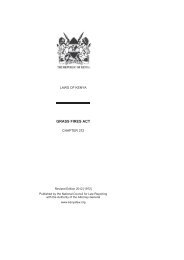Bench Bulletin - Issue 12 - Kenya Law Reports
Bench Bulletin - Issue 12 - Kenya Law Reports
Bench Bulletin - Issue 12 - Kenya Law Reports
Create successful ePaper yourself
Turn your PDF publications into a flip-book with our unique Google optimized e-Paper software.
KENYA LAW REPORTS<br />
BENCH BULLETIN<br />
FROM THE COURTS — COURT OF APPEAL<br />
Procedure For Production of Exhibits<br />
Chris Kasamba Karani V Republic<br />
Criminal Appeal No. 26 Of 2008<br />
Tunoi, Bosire & Onyango Otieno, JJ A<br />
Court of Appeal at Nakuru<br />
May 28, 2010<br />
Reported by Njeri Githang’a<br />
Case History<br />
(Appeal from a judgment of the High Court of <strong>Kenya</strong> at Nakuru (Koome & Kimaru, JJ.) dated 24th January, 2008 in<br />
H.C.CR.A. NO. 199 OF 2004)<br />
The Hon. Mr. Justice<br />
P. K. Tunoi<br />
Criminal Practice and Procedure- second appeal-appeal against conviction and sentence -<br />
appellant convicted of robbery with violence-appeal restricted to matters of law- circumstances<br />
under which an appellate court would interfere with the decision of the superior court-Criminal<br />
Procedure Code (Cap 75) section 361<br />
Criminal Practice and Procedure-exhibits- procedure for production of exhibits- need for<br />
an exhibit to be identified before being produced as evidence-where an exhibit was irregularly<br />
produced-where the irregular production of the exhibit did not affect any ingredient of the<br />
offence- where the court could still have enter conviction without the weapon being produced<br />
as exhibit - whether the appeal could be allowed on that ground in circumstances<br />
Criminal Practice and Procedure-trial process-judgment and sentencing-trial court required<br />
to receive mitigating circumstances after finding the appellant guilty before proceeding to<br />
pronounce sentence- mitigating circumstances on record would be of importance when assessing<br />
an appropriate sentence on appeal<br />
Evidence-identification evidence-principles that the court had to take into when dealing with<br />
evidence of identification where the accused claimed it was mistaken identity- appellant caught red handed-whether<br />
there was proper identification<br />
The appellant had been charged with robbery with violence contrary to section 296 (2) of the Penal Code. After full<br />
trial, he was convicted and was sentenced to death. His appeal to the High Court was dismissed resulting to a second<br />
and final appeal to the Court of Appeal.<br />
It was argued that the High Court erred in law by sustaining the finding of the subordinate court despite the testimony<br />
of PW1 and PW2 being deficient of credibility. It was submitted that there was no proper identification of the appellant.<br />
It was further argued that the High Court erred in law by sustaining the finding of the subordinate court despite of the<br />
exhibits being produced contrary to the law.<br />
Held:<br />
1. By dint of section 361 of the Criminal Procedure Code, the court was enjoined to consider only matters of law. The<br />
court could not interfere with the decision of the superior court on facts unless it was demonstrated that;<br />
a. the trial court and the first appellate court considered matters they ought not to have considered or<br />
b. they failed to consider matters they should have considered or<br />
c. looking at the evidence as a whole, they were plainly wrong in their decision, in which case, such omission or<br />
commission would be treated as matters of law.<br />
Whether PW1 and PW2 were credible witnesses were matters of fact and the court would be very reluctant to interfere<br />
with the concurrent findings of the two courts on such matters.<br />
2. The guidelines as regards the principles that the court had to look into when dealing with evidence of identification<br />
where the accused claimed it was mistaken, including that of identification by recognition were;<br />
a. Where the only evidence against a defendant was evidence of identification, or recognition, a trial court was<br />
enjoined to examine such evidence carefully and to be satisfied that the circumstances of identification were<br />
favourable and free from possibility of error before it could safely make it the basis of a conviction.<br />
b. Recognition could be more reliable than identification of a stranger but mistakes in recognition of close<br />
relatives and friends were sometimes made.<br />
3. The appellant had been caught red handed and his defence which was rejected after due consideration by the two<br />
court’s below was indeed ousted by clear and credible evidence adduced by the prosecution.<br />
4. Exhibit 1 had been irregularly produced. Following the correct procedure in law, PW2 should have identified<br />
that exhibit and it should have been marked for identification before PW3 produced it as exhibit. However nothing<br />
turned on that irregularity because the production of that exhibit did not affect any ingredient of the offence. The<br />
46<br />
<strong>Issue</strong> <strong>12</strong>: April-June 2010



